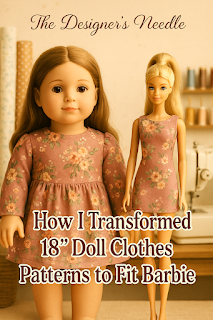 |
| From big to Barbie—see how I resized 18" doll clothes patterns to create one-of-a-kind Barbie fashions. |
How I Put My Creativity To Work for 18-Inch Dolls and 11 1/2-Inch Barbies!
Where there’s a will, there’s a way—that’s always been my motto. One day, while browsing 18-inch doll clothes patterns, I was inspired: Why not transform them to fit Barbie? The basic principles were the same, and I already had the tools—just a printer, creativity, and my love for doll fashion. That’s how I began turning 18-inch doll clothes into one-of-a-kind outfits for 11.5" Barbie dolls, which worked beautifully. In this sewing tutorial, I’ll show you how I transformed 18-inch doll clothes patterns to fit an 11.5" Barbie—no special software needed!
Nearly two decades later, I’m still using this clever shortcut—and now I’m sharing it with you!
The Spark of the Idea
Eighteen years ago, I was sewing clothes for 18-inch dolls like American Girl. One day, I was curious, so I placed a doll clothes pattern on my printer bed and reduced the scale using the printer settings. After printing the pattern at a smaller size, I had my very first Barbie-sized version—and a whole new creative path opened up!
Resizing Tips That Worked for Me
Use your printer’s scale settings: Start with 60%–65 % for 11.5” Barbie proportions.
✂️ Test print a small piece first: Try the bodice front before committing to the complete set.
Adjust small details: Neckline depth, seam allowance, and armhole curves may need refinement.
Choose lighter materials: Lightweight cottons and tiny trims suit Barbie’s scale best.
Mixing and Matching for Style
Instead of just one pattern, I combined favorites: a skirt from one design, a top from another, and sleeves from a third. This mashup method gave me fresh, original Barbie clothes every time—and it was fun!
Selling Original Creations
As I perfected the resizing process, I began listing these outfits on selling platforms. Their handmade charm and creative flair made them stand out—and they sold!
Why This Idea Still Matters Today
Give new life to old or vintage patterns.
Avoid buying new Barbie patterns by reusing what you have.
Stretch your creativity with custom looks.
Save time by adapting rather than drafting from scratch.
If you love sewing for dolls, try this creative shortcut. Reducing 18-inch doll patterns for Barbie isn’t just clever—it’s a doorway into endless miniature fashion possibilities.
Join the conversation:
Have you tried resizing doll clothes patterns? I’d love to hear about it in the comments. And don’t forget to click here to visit my The Needle Market Shop for more patterns, fabrics, and sewing inspiration.





